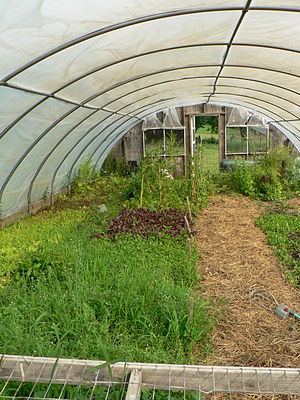I got
a book on lasagna gardening
for Christmas this year, and I can't wait to try it! You may have heard of lasagna gardening, but if you're not quite sure what it is, or you haven't tried it yet yourself, you may be wondering just what is lasagna gardening, and how do you do it properly?
Lasagna gardening is a method that suits organic gardens very well, because it creates a naturally rich, loose soil that is perfect for growing without heavy fertilizers or soil additives. It also works very well for people who do not have a lot of time to spend on their garden. Basically, it is a no-till, no-dig garden that builds beds in layers - hence the name.
When you are preparing a lasagna gardening bed, you do not dig it. Instead, you add layers of organic material on top of the ground that will slowly decompose to form the perfect growing environment. You do not even have to remove weeds because you will kill them by stopping the light reaching them, and they will break down into more compost.
To form the first layer in your lasagna garden bed, cover the whole bed area with brown (unbleached) carton cardboard or inch-thick layers of newspaper (wet newspaper may be easiest to work with). Be careful to cover all existing growth completely, so that weeds cannot poke through and survive. Then water this layer to dampen it (if you haven't already used wet paper). This will attract worms, who will do the real work in your lasagna garden.
On top of the cardboard or newspaper, you can put all of the same types of matter that you would put on a compost heap, i.e. leaves, prunings and grass clippings, fruit and vegetable peelings, coffee grounds, shredded paper, sawdust etc. Just like in a lasagna, you should aim to alternate layers of dry or 'brown' material such as dead leaves, shredded paper and sawdust (the 'pasta') with layers of moist or 'green' material such as food peelings and grass clippings (the 'sauce'). It is better not to use weeds unless you are sure that there are no seeds. You can also use hay, straw, compost, barn litter, seaweed, or whatever other materials you may have access to.
Repeat the layers until the bed is about two feet high. To have enough material to do this, you will probably need to concentrate on a small area of garden at one time. You really do need this much, because it will break down and become a lot smaller over the weeks ahead.
If your intention is to plant in your new bed right away, you will need to add layers of soil or compost and finish with one of those layers on the top to plant in. This will mean that your plants have something to establish themselves in.
But most people build their lasagna beds in the fall or early winter when there are plenty of fallen leaves and waste material from the garden to use. Then you can simply use the brown and green layers without additional soil or compost, and leave it for several months. Winter rain and frost will help everything to be ready for spring planting.
Lasagna gardening is a great way to establish new garden beds. You are saved all of the heavy work of digging into uncultivated land. There are hardly any weeds because the cardboard or newspaper that you used as a first layer will have killed them off. The soil that is produced is soft and easy to work as well as being naturally rich in nutrients, and the worms will work everything into the soil under the bed, so you'll end up with a lovely garden bed with almost no work. All in all, lasagna gardening is perfect for any type of garden, but it is especially great for starting a new organic garden in a new area - it sure is a lot less work than doing all that heavy digging!
For More Info On Lasagna Gardening, Check Out:












